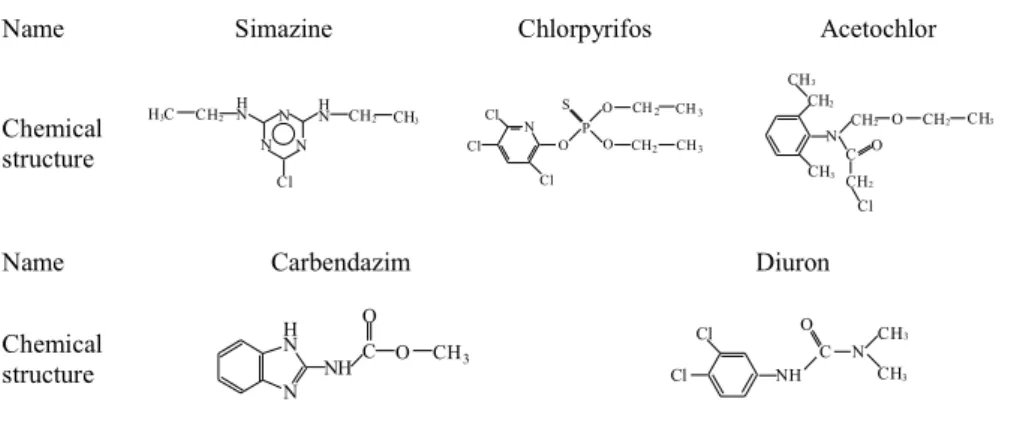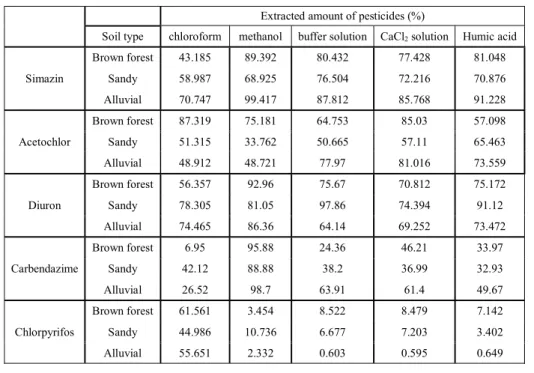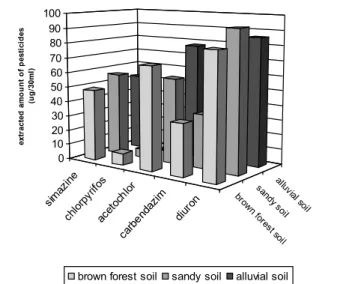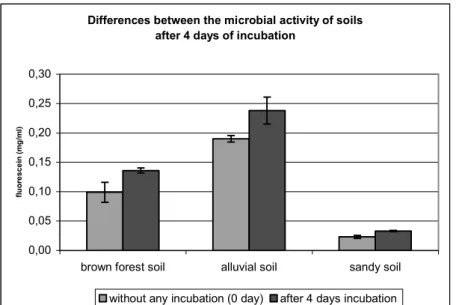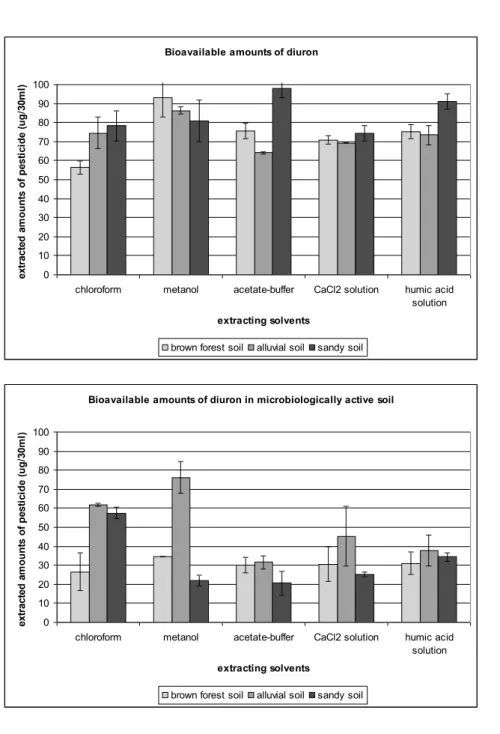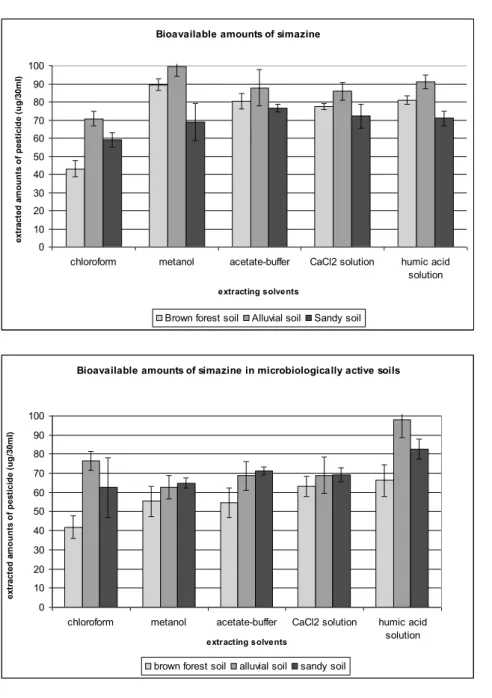DIÁNA VIRÁG
*– ATTILA KISS
*COMPARISON OF NOVEL MODEL SYSTEMS FOR CHARACTERISING PESTICIDES BIOAVAILABILITY
AND THE ROLE OF SOIL MICROORGANISMS
Abstract
Extent of interactions between pesticides and soils varies on a large scale.
As a result of adsorption processes it is of high interest to model bioavailability of widely used pesticides, as well as to compare this feature to obtain adequate data on prospective toxicological problems. Our work signifies major innovations in terms of applying different extraction model systems and involving pesticides have not been studied so far for bioavailability.
Our major goal was to make a comprehensive comparison between different experimental methods to model bioavailability of pesticides and to find the most efficient one. The applied 5 extraction models showed diverse efficiency in extracting capability of pesticides. The five pesticides examined were simazine, carbendazim, acetochlor, chlorpyrifos and diuron. For the examination sandy, brown forest and alluvial soils were applied. The extracted amounts were determined by GC/MS and HPLC/MS techniques.
Our studies involved comparative studies of sterilized and real soil samples to estimate the extent of the microbiological degradation processes in case of three pesticides: simazine, diuron and acetochlor.
3 extraction models proved to be suitable for assessment of the available amount of pesticides for living organisms. As a result both the adsorption capabilities of soils and biological accessibility of pesticides could be estimated in accordance with the microbiological characteristics of soils.
Key words: pesticides, bioavailability, extraction models, pesticide soil interaction, microbial activity.
Introduction
Chemical components being present in the environment are available for organisms to various extent thus they exert diverse effects on ecosystems [1]. The
* EGERFOOD Regional Knowledge Centre, Eszterházy Károly University, Leányka
characterization of pesticide bioavailability [2], particularly in soils, could be considered as a key factor in implementation of environmental risk assessment [3].
There are over 2000 species of soil-microorganisms with variable sensitivity and affinity to pesticides. Extra adsorbing surface for pesticides is provided by the presence of these organisms and their metabolites, moreover the effect of their enzymatic activity should also be taken into account. The influence of pestcides (e.g. atrazine, paraquat, glyphosate, carbaryl) on soil enzymatic activites has already been justified [4], but revealing its conjunction with the bioavailability of pesticides has been neglected so far. To estimate the extent of the microbial effect of soils on pesticide bioavailability, our integrated soil bioecosystem studies have been performed by applying sterilized, air dried and real soil samples. Method based on the hydrolysis of fluorescein diacetate [3’,6’-diacetylfluorescein (FDA)] is a feasible way of measuring microbial activity as several enzymes are involved in the hydrolysis of FDA [5,6,7]. The product of this enzymatic reaction is fluorescein, which can easily be measured spectrophotometrically.
To find the most efficient way of chemical extraction procedures for predicting bioavailability of butachlor and myclobutanil in soil, 6 different types of solvents were applied in order to determine the extractable amounts [8].
According to the experimental data the extractability of the studied pesticides was linearly correlated with their bioavailability to Eisenia foetidaand Allolobo- phora caliginosa.
Behaviour of [14C]-hydroxy-simazine in a Luvisol soil was examined to estimate its residues at different incubation times [9]. Bioavailability of [Carbonyl-14C]-methabenzthiazuron in soil was also studied [10] in case of winter wheat. 0.01 M CaCl2 solution and organic solvents were used for the extractions.
Influence of soil aging and a simazine-mineralizing bacterium on sorption and bioavailability of simazine was studied by applying solvent extraction methods [3]. The applied consecutive extraction method with 0.01 M CaCl2and aqueous methanol (8:2, v/v methanol/water) was proved to be suitable for estimation of bioavailable residues of simazine in aged soils.
Leaching of several pesticides and their sorption behaviour were investigated under diverse circumstances. The adsorption constants showed relation with the soil organic carbon content (OC) and with the soil structure [11, 12, 13, 14, 15], and the mobility was found to be a factor strongly influencing bioavailability of pesticides.
To sum up the outcome of previous examinations it could be established that they were focused on detection of pesticide residues in soils, plants or invertebrate animals by applying limited number of extracting solvents of not versatile chemical feature. Extensive and thorough comparison of markedly
different model systems has not been accomplished yet. In this respect our investigations signify important contributions to the current relevant knowledge.
Materials and Methods
1. Studied pesticides and soils
The five pesticides examined (table 2.) having diverse chemical structures and behaviour are the following: simazine (6-chloro-N2,N4-diethyl-1,3,5- triazine-2,4-diamine), chlorpyrifos (O,O-diethyl O-(3,5,6-trichloro-2-pyridyl)- phosphorothioate), acetochlor (2-chloro-N-(ethoxymethyl)-N-(2-ethyl-6- methylphenyl)-acetamide), carbendazim (methyl benzimidazol-2-ylcarbamate) and diuron (N-(3,4-dichlorophenyl)-N,N-dimethyl urea).
Three types of soils were applied during the experiments: sandy, brown forest soil with clay illuviation and alluvial soil. The plough layer was examined, the major characteristics were precisely determined in terms of pH, specific conductivity, organic matter content (OM) and granulometric composition by using traditional methods (table 1).
Table 1: Physical and chemical properties of soil samples.
Soil type Sand
(m%) Rock-flour
(m%) Mud
(m%) Clay
(m%) pH
(H2O)
Spec.
conductivity ( s/cm)
OM (%)
Sandy 94.8 5.2 0.0 0.0 6.53 64.2 2.06
Brown
forest 6.0 41.0 31.0 22.0 6.60 82.0 5.94
Alluvial 34.1 41.3 24.6 0 7.96 111 7.07
Table 2: The Chemical structures of the pesticides.
Name Simazine Chlorpyrifos Acetochlor
Chemical structure
H H
3C H H
N N
N N
C 2 N CH2 CH3
Cl
3 N
Cl Cl
Cl O O
P
S O
2 CH CH CH
2 CH 3
O N O
Cl C H
2
C 3
H
CH3
C CH3
CH2
CH2
CH2
Name Carbendazim Diuron
Chemical structure
N NH
N C O H O CH3
N
Cl H CH3
H3
O C C N Cl
2. Sample preparation
The pesticides were dissolved in methanol to reach 200 ppm concentration.
The 5 applied extraction model systems were as follows: chloroform, aqueous methanol (8:2, v/v methanol/water), Na-acetate - acetic acid buffer (pH=5.6), CaCl2 solution (0.01 M) and humic acid solution (0.5 v/v% SERA humic acid solution).
10 g of each soil samples were combined with 5 ml of each pesticide solution (methanol – water). The soil samples containing pesticides have been dried at 105ºC for 2 hours, than powdered, and 1 g were extracted with 30 ml of the extracting solvents for 16 hours. Then the soil samples were centrifuged at 6000 rpm for 10 minutes and 25 ml of the supernatants were extracted with 15 ml of chloroform twice time, then vacuum evaporated. Dry extracts were redissolved in methanol in case of simazine, acetochlor, carbendazim and in acetonitrile in case of chlorpyrifos. The sample preparations were performed in triplicates.
3. Instrumental measurements
The extracted amounts of the basic components were detected by using a GC-GC/MS QP-2010S Shimadzu. In case of carbendazim the extracted amounts was determined by HPLC/MS-2010 EV Liquid Chromatograph Mass Spectrometer, Shimadzu (column: pHidelity C18 (3 µm x 150mm x 4.6 mm) (Restek); eluent: 50:50 methanol:water (0.6 % NH3), pH=11, flow rate: 0.7 ml/minute, detector: PDA, 285 nm).
Data were averaged and the standard error was calculated with Statgraphics 5.0 software.
4. Microbiological experiments
For estimation of the effect of the microbial flora of the soils on the extent of adsorption of pesticides to soil, sterilized, air dried and microbiologically active soils were studied. Microbiological activity of soils was enhanced by the moistening with water and incubating of soils for 4 days at 24ºC. The obtained soil samples with diverse microbial activity were treated with 3 kinds of pesticides (acetochlor, diuron, simazine) and examined according to the abovementioned extracting methods.
The microbial activity of soil samples were determined according to Adam and Dunchan [16] with slight modification: to block the enzymatic reaction five millilitre aliquots of the soil suspensions were taken and amended with 5 ml of acetone. The absorbance of the samples was measured with Hitachi U-2800 Spectrophotometer at 490 nm. During the preparation of the standard samples
50-100-250-500-750 µl of fluorescein stock solution (0.048 mmol fluroescein/10 ml acetone) was added to the soil samples that were previously suspended in buffer solution.
Results and Discussion
1. Bioavailable amounts of pesticides
According to the statistical evaluation of the results it could be stated that the five distinctive types of applied extracting models showed diverse efficiency in terms of extracting the pesticides from the three different types of soil.
In case of simazine acetate buffer, CaCl2 solution and humic acid solution were found to be fairly equally efficient extraction models. Chloroform was the least efficient solvent in case of brown forest soil, while it proved to be suitable for extracting the most amount of simazine from sandy soil. Humic-acid solution was among the most efficient extracting agents for each soil types.
The largest amount of chlorpyrifos could be obtained with the use of chloroform, the other extraction solvents displayed almost the same extraction efficiency: extracted amounts were lower than 10% of the initial amount (table 3).
In case of diuron the efficiency of all the applied extracting solvents were above 80% – except chloroform. Methanol solution was the most effective in terms of mobilizing diuron from brown forest soil, while humic acid solution extracted the most diuron from sandy soil.
For regaining acetochlor from brown forest and alluvial soils CaCl2solution and humic acid were nearly as efficient as chloroform (appr. 80%). From sandy soil less amount of pesticide could be extracted than in case of the other two soil types with the exception of humic acid solution.
In case of carbendazim the efficiency of natural like, aqueous extracting solvents was found to be far below that of methanol (24-64% compared with 89- 99%). It could be established that the bioavailable amounts of carbendazim were conditional on the types of the soil.
To sum up the abovementioned findings it is obvious that the applied solvents showed different extraction capability in terms of different pesticides and three types of soil (figure 1).
Table 3: Bioavailable amounts of the pesticides.
Extracted amount of pesticides (%)
Soil type chloroform methanol buffer solution CaCl2solution Humic acid
Simazin
Brown forest 43.185 89.392 80.432 77.428 81.048
Sandy 58.987 68.925 76.504 72.216 70.876
Alluvial 70.747 99.417 87.812 85.768 91.228
Acetochlor
Brown forest 87.319 75.181 64.753 85.03 57.098
Sandy 51.315 33.762 50.665 57.11 65.463
Alluvial 48.912 48.721 77.97 81.016 73.559
Diuron
Brown forest 56.357 92.96 75.67 70.812 75.172
Sandy 78.305 81.05 97.86 74.394 91.12
Alluvial 74.465 86.36 64.14 69.252 73.472
Carbendazime
Brown forest 6.95 95.88 24.36 46.21 33.97
Sandy 42.12 88.88 38.2 36.99 32.93
Alluvial 26.52 98.7 63.91 61.4 49.67
Chlorpyrifos
Brown forest 61.561 3.454 8.522 8.479 7.142
Sandy 44.986 10.736 6.677 7.203 3.402
Alluvial 55.651 2.332 0.603 0.595 0.649
0 10 20 30 40 50 60 70 80 90 100
The methanol extractable amount of the studied pesticides
brown forest soil sandy soil alluvial soil
0 10 20 30 40 50 60 70 80 90 100
The average of the extracted amounts of the studied pesticides by the aqueous extracting solvents (buffer, CaCl2, humic acid)
brown forest soil sandy soil alluvial soil
Figure 1: Comparison of the extractive efficiency of the aqueous solvents with the meth- anol-solution.
2. Effects of the microbial activity of soils on the bioavailable amounts of pesticides
The activity of the all soil types displayed marked differences between the 1. and 4. day, and obvious increase might have been observed with a maximum value on day 4 (figure 2).
In figure 3. it is clearly demonstrated that bioavailable amounts of diuron show inverse proportionality with the microbiologic activity all of the soils. In case of air-dried soil samples 65–98% of the initial amount of diuron could be extracted, while from microbiologically active soils even less pesticide was gained. It could be observed that the soils having enhanced microflora adsorb more acetochlor thus fewer amount of the initial concentration could be extracted (12–31%) (figure 4.). During the extraction procedures decreasing amounts of simazine was obtained in case of the microbiologically active soil samples however these differences were not as pronounced as in case of diuron and acetochlor (figure 5.).
All of both cases fewer pesticides were obtained from microbiologically active soil than the air-dried soil samples. These tendencies are apparently manifested in case of the three types of soils. It is obvious that the presence of the soil microorganisms and their metabolic products provides more adsorbing
surface for the pesticides. According to the results of our studies focusing on estimating the effect of microflora of each soil on the bioavailable amount of different types of pesticides it could be stated that fewer amounts of the pesticides could become bioavailable for the living organisms in case of soils having a well-balanced microflora.
Differences between the microbial activity of soils after 4 days of incubation
0,00 0,05 0,10 0,15 0,20 0,25 0,30
brown forest soil alluvial soil sandy soil without any incubation (0 day) after 4 days incubation
Figure 2. Microbial activity of the 3 soil types after 4 days of incubation
The error bars represent the LSD (Least Significant Difference) of the data at a confidence level of 95%.
Bioavailable amounts of diuron
0 10 20 30 40 50 60 70 80 90 100
chloroform metanol acetate-buffer CaCl2 solution humic acid solution extracting solvents
brown forest soil alluvial soil sandy soil
Bioavailable amounts of diuron in microbiologically active soil
0 10 20 30 40 50 60 70 80 90 100
chloroform metanol acetate-buffer CaCl2 solution humic acid solution extracting solvents
brown forest soil alluvial soil sandy soil
Figure 3. Bioavailable amounts of diuron in untreated and microbiologically active soils.
Bioavailable amounts of acetochlor
0 10 20 30 40 50 60 70 80 90 100
chloroform methanol acetate-buffer CaCl2 solution humic acid solution extracting solvents
brown forest soil alluvial soil sandy soil
Bioavailable amounts of acetochlor in microbiologically active soils
0 10 20 30 40 50 60 70 80 90 100
chloroform metanol acetate-buffer CaCl2 solution humic acid solution extracting solvents
brown forest soil alluvial soil sandy soil
Figure 4. Bioavailable amounts of acetochlor in untreated and microbiologically active soils.
Bioavailable amounts of simazine
0 10 20 30 40 50 60 70 80 90 100
chloroform metanol acetate-buffer CaCl2 solution humic acid solution extracting solvents
Brown forest soil Alluvial soil Sandy soil
Bioavailable amounts of simazine in microbiologically active soils
0 10 20 30 40 50 60 70 80 90 100
chloroform metanol acetate-buffer CaCl2 solution humic acid solution extracting solvents
brown forest soil alluvial soil sandy soil
Figure 5. Bioavailable amounts of simazin in untreated and microbiologically active soils.
CONCLUSIONS
Investigation of different solvent extraction methods in order to compare and model pesticide-soil interactions proved to be an efficient tool to obtain precise data on soil-binding capabilities of some widely used pesticides. Thus we gained insight into the bioavailability of these important soil contaminants, as well as created models to describe actual environmental processes.
According to the results of our studies on revealing the relation of microflora and the bioavailable amount of different types of pesticides, it could be stated that the air-dried soils could not adsorb as much pesticide as soils with active microbiological flora. As a consequence the influence of microbiological systems on pesticide bioavailability might be concluded
The five distinctive types of applied extracting solvents displayed different effectivity in mobilizing pesticides from soil. Among studied pesticides diuron was found to be the most mobile pesticide. It was observed that alluvial and brown forest soil adsorbed more effectively pesticides than sandy soil.
Averagely the aqueous extracting solvents proved to be nearly as effective in terms of extracting pesticides as chloroform. In general terms it might be stated that natural-like extraction methods provided significantly efficient and excellent models for estimation of bioavailabilty. The observed marked differences could be explained by the diverse chemical structure of the pesticides, the variable adsorbing capacity of the three kinds of soils and the highly different characteristic of the applied extracting solvents. As a result of our studies a clarified picture could be acquired to characterize pesticides-soil interaction and to model pesticides’ fate in the natural environment.
Acknowledgements
The authors thank the National Office for Research and Technology for financial support of this work (RET 09/2005 NKTH project).
References
[1] Southgate D, Johnson I, Fenwick GR. 1989. Nutrient Availability: Chemical and Biological Aspects.Royal Society of Chemistry, Cambridge, UK.
[2] Maier R. 2000. Bioavailability and its importance to bioremediation. In Valdes JJ.
eds,International Society for Environmental Biotechnology: Environmental Mo- nitoring and Biodiagnostics. Chapter in: Bioremediation, Kluwer Academic Publishers, Norwell, MA, pp. 59–78.
[3] Regitano JB, Koskinen WC, Sadowsky MJ. 2006. Influence of Soil Aging on Sorption and Bioavailability of Simazine. J Agric Food Chem54:1373–1379.
[4] Sannino F, Gianfreda L. 2001. Pesticide influence on soil enzymatic activities.
Chemosphere22:1–9.
[5] Brunius G. 1980. Technical aspects of 3’,6’-diacetyl fluorescein for vital fluorescent staining of bacteria. Current Biology4:321–323.
[6] Lundgren B. 1981. Fluorescein diacetate as a stain of metabolically active bacteria in soil. Oikos36:17–22.
[7] Schnürer J, Rosswall T. 1982. Fluorescein diacetate hydrolysis as a measure of total microbial activity in soil and litter. Appl Environ Microbiol6:1256–1261.
[8] Yu YL, Wu XM, Li SN, Fang H, Tan YJ, Yu JQ. 2005. Bioavailability of butachlor and myclobutanil residues in soil to earthworms. Chemosphere59:961–967.
[9] Kloskowski R, Führ F. 1985. Behaviour of [ring-14C] hydroxy-simazine in a parabraun soil. Chemosphere 14:1913–1920.
[10] Kloskowski R, Fuhr F. 1987. Aged and bound herbicide residues in soil and their bioavailability. Part 2: Uptake of aged and non-extractable (bound) [carbonyl- 14C] methabenzthiazuron residues by maize. Journal of Environmental Science Health B22:623–42.
[11] Landry D, Dousset S, Andreux F. 2004. Laboratory leaching studies of oryzalin and diuron through three undisturbed vineyard soil columns. Chemosphere 54:735–
742.
[12] Ma QL, Rahman A, James TK, Holland PT, Mcnaughton DE, Rojas KW, Ahuja LR. 2004. Modeling the Fate of Acetochlor and Terbuthylazine in the Field Using the Root Zone Water Quality Model. Soil Science Society Of America Journal 68:1491–1500.
[13] Taylor JP, Mills MS, Burns RG. 2004. Sorption and desorption behaviour of acetochlor in surface, subsurface and size-fractionated soil. European Journal of Soil Science55:671–679.
[14] Nemeth-Konda L, Füleky Gy, Morovjan Gy, Csokan P.2002. Sorption behaviour of acetochlor, atrazine, carbendazim, diazinon, imidacloprid and isoproturon on Hungarian agricultural soil. Chemosphere48:545–552.
[15] Leistra M, Matser AM. 2004. Adsorption, transformation, and bioavailability of the fungicides carbendazim and iprodione in soil, alone and in combination. Journal of Environmental Science Health B39:1–17.
[16] Adam G, Duncan H. 2001. Development of a sensitive and rapid method for the measurement of total microbial activity using fluorescein diacetate (FDA) in a range of soils. Soil Biology and Biochemistry33:943–951.
Figure legends:
Figure 1: Comparison of the extractive efficiency of the aqueous solvents with the methanol-solution.
Figure 2. Microbial activity of the 3 soil types after 4 days of incubation.
Figure 3. Bioavailable amounts of diuron in untreated and microbiologically active soils.
Figure 4. Bioavailable amounts of acetochlor in untreated and microbiologically active soils.
Figure 5. Bioavailable amounts of simazin in untreated and microbiologically active soils.
